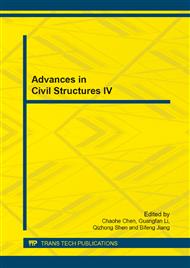p.1482
p.1489
p.1493
p.1498
p.1504
p.1512
p.1522
p.1531
p.1538
Influence of Splitting Load and Polypropylene Fiber on Permeability of Chloride Ion in Concrete
Abstract:
Orthogonal experiment is used to study the influence of splitting load and mixing of polypropylene fiber of different volume fraction, different length and different mass ratio of long and short fiber on permeability of chloride ion in concrete. The results show that the chloride ion diffusion coefficient increases as the stress ratio increasing, and the relationship between them approximately agrees with exponential function. The influences of fiber volume fraction and fiber length on permeability of chloride ion in concrete are significant, and using shorter polypropylene fiber in the range of low volume fraction can lower permeability of chloride ion in concrete, whereas long fiber and large volume fraction will increase the permeability. The effect of lowering permeability of chloride ion in concrete is most obvious, when the fiber volume fraction is 0.1%, the fiber length is the combination of 6mm and 9mm, and the mass ratio of long and short fiber is 1:2.
Info:
Periodical:
Pages:
1504-1511
Citation:
Online since:
July 2014
Authors:
Price:
Сopyright:
© 2014 Trans Tech Publications Ltd. All Rights Reserved
Share:
Citation:


